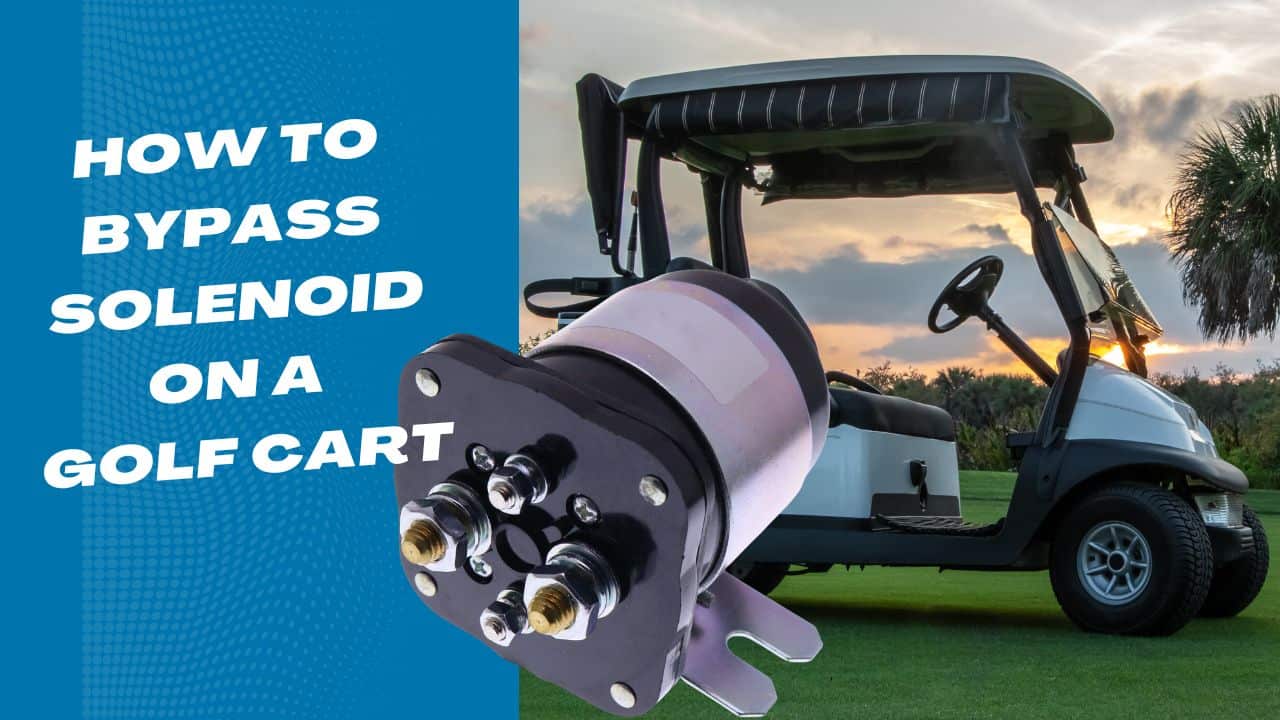How To Bypass Solenoid On Golf Cart?(With Diagram and Video)

Does your golf cart have performance issues? Here is an informative guide that tells you how to bypass solenoid on golf cart in step-by-step instructions.
Golf carts, like any other vehicle, rely on several key components to operate smoothly. One such piece is the solenoid, a switch that controls the electric current flowing through the cart.
When it’s working correctly, the solenoid ensures the golf cart can start and stop efficiently. However, sometimes it may fail, leading to performance issues. In such cases, bypassing the solenoid might be necessary.
Therefore here is everything you need to know about how you can safely bypass a solenoid on a golf cart.
I. What is a solenoid in a golf cart?
The solenoid is a vital relay switch in golf carts, powering the electrical system in electric golf carts and assisting with ignition in gas carts.
The solenoid, powered by an electrical motor power circuit, consists of two main parts: the coil and a steel plunger and operates as an electromagnetic switch.
When you turn the ignition key, the solenoid springs into action, allowing electricity to flow from the battery to the motor, thus starting the golf cart. A functioning solenoid is essential for proper cart operation.
II. Can You Bypass A Golf Cart Solenoid?
Bypassing a golf cart solenoid is possible. But, you should consider this option only in emergency situations or as a last resort.
Bypassing the solenoid involves creating a direct connection between the battery and the traction motor.
However, this approach carries potential safety risks and may cause damage to the cart’s electrical system if not executed correctly. Therefore, it should be approached with caution and only used when absolutely necessary.
III. How to bypass solenoid on golf cart?
Bypassing the solenoid in your golf cart is an option in emergency situations when you need a temporary fix to get your cart moving. However, this method is not a permanent solution.
If you find yourself in a bind and need to bypass the solenoid, follow these steps with utmost caution:
Step 1: Take Safety Measures
Before attempting to bypass the solenoid, prioritize safety to avoid any potential hazards. Wear work gloves and safety glasses to protect yourself during the process. Additionally, have a fire extinguisher nearby in case of any unexpected electrical issues.
Step 2: Locate the Solenoid
The first step is to locate the solenoid in your golf cart. Typically, you can find it near the battery compartment or on the inside of the cart in that vicinity.
Step 3: Bypassing Solenoid process
To bypass the solenoid, you’ll need to create a direct path for the current to reach the motor, circumventing the faulty solenoid. Use insulated wires to connect the two large terminals on the solenoid.
This direct connection will allow the current to flow freely to the motor, bypassing the solenoid’s function.
IV. Symptoms Of faulty Solenoid On Golf Cart
Some common symptoms of a faulty solenoid on a golf cart include:
1. Clicking noise
When you turn the key or press the accelerator pedal, you may hear a clicking sound from the solenoid. This indicates that the solenoid is receiving the electrical signal but may not be engaging properly.
2. No response or starting issues
One of the symptoms of a faulty solenoid in a golf cart is a lack of response when attempting to start the vehicle.
Additionally, there may be a noticeable delay before the golf cart starts moving. In some cases, the cart may start intermittently but fail to start consistently. These issues can be indicative of solenoid problems and should be addressed to ensure the proper functioning of the golf cart.
3. Burning smell
If you detect a burnt smell around the solenoid, it could indicate an internal electrical failure. This distinct odor suggests potential issues within the solenoid and requires prompt attention to prevent further damage or safety hazards.
4. Dimming or flickering lights
Dimming or flickering lights can be another sign of a bad solenoid in a golf cart. When the solenoid malfunctions, it can disrupt the electrical flow to other components, including the lights, causing them to appear dimmer or flicker during operation.
V. How To Test Golf Cart Solenoid?
If you are stranded at the far end of the golf course and want to check the solenoid of your cart, you can follow these simple steps.
However, if you have access, it is always recommended to transport your cart to a mechanic for maintenance and repairs.
Tools required:
- A basic voltmeter or multimeter
- 1/2″ wrench (recommended size)
- Electrical tape to cover cable ends during the testing process
- Gloves and safety glasses
1. Gas golf cart solenoid
- Switch the gas golf cart to the “Off” position.
- Use the ohms feature on the voltmeter or multimeter and make contact with the probes to the larger terminals. If you get a reading of zero, that means everything’s working fine.
- Set the key to the “On” position and put the cart in “Drive.”
- Apply pressure to the pedal and listen for a clicking sound.
- Concurrently, check the voltmeter reading. A reading of under 0.4 ohms indicates a working solenoid, while anything above that suggests a faulty solenoid that needs replacement.
2. Electric golf cart solenoid
- Get a voltmeter and set it to the DC volt setting in the 200 range. This will allow you to measure the voltage accurately.
- Turn on the ignition key and place the voltmeter probes on the smaller terminals of the solenoid. Take note of the voltmeter reading.
- If you don’t get any reading, depress the accelerator pedal while keeping the ignition on. Watch the voltmeter needle for any movement or indication of voltage.
- If the voltmeter needle shows full voltage while depressing the accelerator, it suggests a faulty solenoid that needs replacement.
- On the other hand, if there is no activity on the voltmeter during the accelerator test, the solenoid is not the cause of the issue.
VI. Solenoid not clicking: Causes and solution
If the solenoid is not clicking when you attempt to start the golf cart, there could be several reasons:
- Low Battery Voltage: Insufficient voltage in the golf cart batteries may prevent the solenoid from engaging. Charge or replace the battery if needed. Moreover, cleaning the battery terminals can help keep the battery life and ensure a reliable, current flow.
- Loose Connections: Check all electrical connections on the solenoid and tighten them if necessary.
- Corrosion: Corrosion on the terminals can disrupt the electrical flow. Clean the terminals to ensure proper contact.
- Defective Ignition Switch: The ignition switch may not be sending the electrical signal to the solenoid. Test and replace the ignition switch if needed.
VII. EZ GO golf cart solenoid wiring diagram to help you bypass solenoid
An E-Z-GO golf cart solenoid wiring diagram is a valuable tool that provides a visual representation of the solenoid’s electrical connections in the golf cart.

Whether you need to troubleshoot electrical problems, test the solenoid, or install a new one, the wiring diagram can be a helpful resource.
Step 1: Familiarize Yourself with the Diagram
Start by familiarizing yourself with the solenoid wiring diagram. It will display the solenoid’s location within the golf cart and illustrate the color-coded wires connected to it. The color coding helps identify different electrical connections, making the process easier to follow.
Step 2: Identify the Wires
Identify the wires connected to the solenoid in your golf cart. The diagram will assist you in recognizing each wire’s function and where it should be connected.
Step 3: Trace Electrical Connections
Use the solenoid wiring diagram to trace the electrical connections from the solenoid to the battery and the motor. This will help you understand the path of the electrical current and identify any potential faults or issues.
Step 4: Troubleshooting Electrical Problems
If you encounter electrical problems in your golf cart, the wiring diagram can be a valuable aid. By referring to the diagram, you can identify and locate any faulty connections and rectify the issues accordingly.
Step 5: Testing the Solenoid
To test the solenoid, use the diagram to correctly connect it to the battery and the motor. This will enable you to check if the solenoid is functioning properly and if it is the cause of any problems in the golf cart’s electrical system.
Step 6: Installing a New Solenoid
When installing a new solenoid, the wiring diagram becomes essential. It will guide you in making the correct connections between the solenoid, battery, and motor, ensuring a successful installation.
Conclusion
While bypassing a solenoid on a golf cart is possible, it should only be done as a last resort and with proper knowledge and care. Always remember to troubleshoot safely and consult with a professional if you’re unsure about the process.








